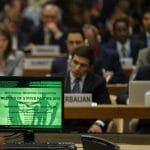Biodevelopment and the Biological Weapons Convention
By Malcolm Dando | July 14, 2009
It’s not uncommon for some biosecurity colleagues to dismiss the Biological Weapons Convention (BWC) as a regime with an inadequate mandate. Peter Singer and Abdullah Daar, for example, suggest as much in a recent Bulletin article. In it, they argue that we should reconcile “the bright and dark sides of biotechnology” outside of the BWC in a new initiative that has the single purpose of putting biotechnology to use for the good of human security. The implication is that current intergovernmental processes aren’t well suited to achieve these goals, particularly if they’re dominated by Western concerns. Instead, they posit, we need a more flexible approach that incorporates more actors from the international community.
On some broad aspects, I agree with Singer and Daar. They correctly point out that the BWC involves both biosecurity and biodevelopment, but that nevertheless, the convention is weak because it has no effective enforcement mechanism and no major international organization to help accomplish its goals. They go on, however, to make the incorrect assertion that “while it binds signatory states, it does not catch the non-state actors that are essential to matters of biotech governance.” In fact, through the necessary national implementing legislation, the convention binds not just states but everyone in the territory of State Parties or in other places under their jurisdiction or control.
The Intersessional Process meetings have not only involved diplomats, but also have been imaginatively expanded by successive chairmen to incorporate more of the relevant stakeholders.”
By pointing out the flaws of the BWC without taking into account the way that State Parties have developed interim reviews and meetings via the Intersessional Process, Singer and Daar have ignored important aspects of the BWC that seek to benefit biotechnology and biodevelopment. As in other international agreements concerned with weapons of mass destruction (e.g., the Nuclear Nonproliferation Treaty or Chemical Weapons Convention) the BWC includes Article 10, which deals with the use of the technology for peaceful purposes. State Parties agree to facilitate peaceful use (10.1) and to implement the agreement in a way that does not hinder development (10.2). Furthermore, Article 4 of the BWC, which deals with State Parties’ agreement “to prohibit and prevent” violations of the convention, is often overlooked by critics. Such measures go well beyond simply punishing violators. Indeed, they have come to include in-depth implementation and raising scientists’ awareness of the dangers of misuse of their work.
Since 2003 BWC annual meetings at both the expert and diplomatic levels have been held to “discuss and promote common understanding and effective action” on the topics that can most effectively strengthen the convention. For instance, in 2007, participants took up how to “enhance national implementation, including enforcement of national legislation, strengthening of national institutions and coordination among national law enforcement institutions.” These annual meetings have not only involved diplomats but also have been imaginatively expanded by successive chairmen to incorporate more of the relevant stakeholders–particularly members of national and international scientific communities.
This year’s Intersessional Process meetings will undoubtedly have a solid foundation since their focus has been publicized for quite some time as “enhancing international cooperation, assistance, and exchange in biological sciences and technology for peaceful purposes, promoting capacity building in the fields of disease surveillance, detection, diagnosis, and containment of infectious diseases: (1) for State Parties in need of assistance . . . and (2) from State Parties in a position to do so.”
Ambassador Marius Grinius of Canada, who will chair the 2009 meetings, underlined the importance of cooperation in a letter to State Parties in February. He went on to state that his primary purpose in the meetings was to continue the successful practices evolved since 2003 and “to work closely with State Parties to ensure a productive consensus outcome that helps to strengthen the Convention and enhance the use of biology for peaceful purposes.”
An appendix attached to his letter outlined proposals on engagement, enhancing capacity, background information, and sponsorship to help broaden stakeholders’ participation (particularly those from the developing world). He also suggested that national delegations “include a representative from the National International Health Regulations (IHR) Focal Point established under the 2005 IHR” and listed 17 international organizations, such as the World Health Organization, that were already invited to the meeting.
So despite the BWC’s written deficiencies, Singer and Daar overlook the clear evidence that the Intersessional Process is actively working to support both biosecurity and biotechnology development. Furthermore, they don’t acknowledge that over the years the State Parties have made an effort to cooperate on peaceful development and support those states that need assistance. The upcoming meeting promises no less cooperation than those of the recent past. And until Singer and Daar’s desire for an initiative that addresses biotechnology’s relationship to human security is realized, the BWC and its Intersessional Process are the best hope for reconciling the “bright and dark sides of biotechnology.”
Together, we make the world safer.
The Bulletin elevates expert voices above the noise. But as an independent nonprofit organization, our operations depend on the support of readers like you. Help us continue to deliver quality journalism that holds leaders accountable. Your support of our work at any level is important. In return, we promise our coverage will be understandable, influential, vigilant, solution-oriented, and fair-minded. Together we can make a difference.
Topics: Biosecurity, Columnists















